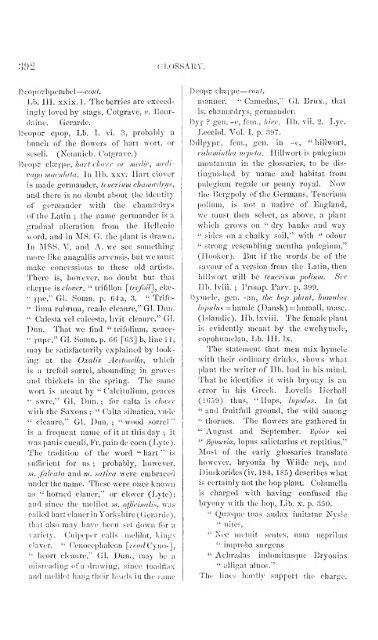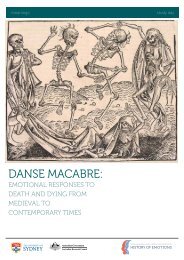Leechdoms, wortcunning, and starcraft of early England. Being a ...
Leechdoms, wortcunning, and starcraft of early England. Being a ...
Leechdoms, wortcunning, and starcraft of early England. Being a ...
Create successful ePaper yourself
Turn your PDF publications into a flip-book with our unique Google optimized e-Paper software.
—<br />
"<br />
—<br />
392 GLOSSARY.<br />
)>eo)iocb]jembel cont.<br />
Lb. III. xxix. 1. The berries are exceedingly<br />
loved by stags, Cotgrave, v. Eourdaine.<br />
Gerarde.<br />
lieoji<strong>of</strong>c cjiop, Lb. I. vi. 3, probably a<br />
bunch <strong>of</strong> the flowers <strong>of</strong> hart wort, or<br />
seseli.<br />
(Nemnich, Cotgrave.)<br />
]>eo)iC cl3C):]ie, hcn't clover or medic, medicago<br />
maculata. In lib. xxv. Hart clover<br />
is made germ<strong>and</strong>er, tcucrium chama'drijs,<br />
<strong>and</strong> there is no doubt about the identity<br />
<strong>of</strong> germ<strong>and</strong>er with the chamscdrys<br />
<strong>of</strong> the Latin ; the name germ<strong>and</strong>er is a<br />
gradual alteration fi-om the Hellenic<br />
word, <strong>and</strong> in MS. G. the plant is drawn.<br />
In MSS. "V. <strong>and</strong> A. we see something<br />
more like anagallis arvensis, but we must<br />
make concessions to these old artists.<br />
There is, however, no doubt but that<br />
clffijjie is clover, " trifillon [_trefoil'], clfc-<br />
" )iie," Gl. Somn. p. 64 a, 3. " Trifo-<br />
" Hum rubrum, reade cleaure," Gl. Dun.<br />
" Calesta vel calcesta, hvit cleaure," Gl.<br />
Dun. That we find " trifolium, s^ace-<br />
" rupe," Gl- Somn. p. 66 [63] b, line 11,<br />
may be satisfactorily explained by looking<br />
at the Oxalis Acetosella, -which<br />
is a trefoil sorrel, abounding in groves<br />
<strong>and</strong> thickets in the spring. The same<br />
wort is meant by " Calcitulium, geaces<br />
" swre," Gl. Dun. ; for calta is clover<br />
with the Saxons ;<br />
" Calta siluatica, vude<br />
" cleaure," Gl. Dun. ;<br />
" wood sorrel<br />
is a frequent name <strong>of</strong> it at this day ; it<br />
was panis cuculi, Fr. pain de cocu (Lyte).<br />
The tradition <strong>of</strong> the word " hart " is<br />
sufficient for us ;<br />
probably, however,<br />
in. falcata <strong>and</strong> m. sativa were embraced<br />
under the name. These were once known<br />
as "horned clauer," or clover (Lyte);<br />
<strong>and</strong> since the melilot m. <strong>of</strong>ficinalis, was<br />
called hart clauer in Yorkshire (Gerarde),<br />
that also may have been set down for a<br />
vaiiety. Culpepor calls melilot, kings<br />
claver. " Cenocephaleon [AeaJCyno-],<br />
" heort cleaure," Gl. Dun., may be a<br />
misreading <strong>of</strong> a drawing, since toadflax<br />
<strong>and</strong> melilot hang their heads in the same<br />
)>eopt clseyjie<br />
cont,<br />
manner. " Camedus," Gl. Brux., that<br />
is,<br />
chanicedrys, germ<strong>and</strong>er.<br />
^^yy gG°' ~C' fem., hive. Hb. vii. 2. Lye.<br />
Leechd. Vol. I. p. 397.<br />
)>ill])y]it, fem., gen. in -e, " hillwort,<br />
cahnnintha riepeta. Hillwort is pulegiuni<br />
montanum in the glossaries, to be distinguished<br />
by name <strong>and</strong> habitat from<br />
I)ulegium regale or penny royal. Now<br />
the Bergpoly <strong>of</strong> the Germans, Teucrium<br />
polium, is not a native <strong>of</strong> Engl<strong>and</strong>,<br />
we must then select, as above, a plant<br />
which grows on " dry banks <strong>and</strong> way<br />
" sides on a chalky soil," with " odour<br />
" strong resembling mentha pulegium,"<br />
(Hooker). But if the words be <strong>of</strong> the<br />
savour <strong>of</strong> a version from the Latin, then<br />
hillwort will be teucrium polium. See<br />
lib. Iviii. ; Promp. Parv. p. 399.<br />
]>ymele, gen. -an, the hop plant, humnlns<br />
hipidus = hvim]Q (Dansk)=humall, masc.<br />
(Isl<strong>and</strong>ic). Hb. Ixviii. The female plant<br />
is evidently meant by the ewehymcle,<br />
coj'ohumelan. Lb. III. Ix.<br />
The statement that men mix hymele<br />
with their ordinary drinks, shows what<br />
plant the writer <strong>of</strong> Hb. had in his mind.<br />
That he identifies it with bryony is an<br />
error in his Greek. Lovells Herball<br />
(16.59) thus, "Hops, lupulus. In fat<br />
" <strong>and</strong> fruitful! ground, the wild among<br />
" thornes. The flowers are gathered in<br />
" August <strong>and</strong> September. Bpvov kcu<br />
" Ppvonvia, lupus salictarius et reptitius."<br />
Most <strong>of</strong> the <strong>early</strong> glossaries translate<br />
however, bryonia by Wilde nep, <strong>and</strong><br />
Dioskorides(iv. 184, 185) describes what<br />
is certainly not the hop plant.<br />
Columella<br />
is charged with having confused the<br />
bryony with the hop. Lib. x. p. 350.<br />
" Qurcque tuas audax imitatur Nysie<br />
" uites,<br />
" Ncc metuit sentes, nam uepribus<br />
" improba surgens<br />
" Achradas indomitasque Bryonias<br />
" alligat alnos."<br />
The lines hardly support the charge.












